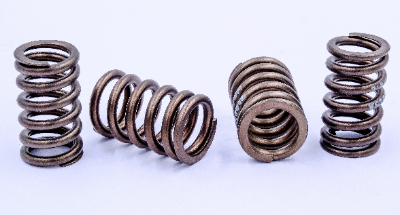What Is a Valve Spring?
 A valve spring is a spring used to close the intake and exhaust valves of an engine. Coil springs are used. The spring material used is piano wire or heat-resistant spring steel.
A valve spring is a spring used to close the intake and exhaust valves of an engine. Coil springs are used. The spring material used is piano wire or heat-resistant spring steel.
Valve springs must be of moderate strength, as too strong a valve spring will not open and close smoothly, and too weak a valve spring will not keep a tight seal. To improve valve motion, composite springs combining two coil springs or unequal pitch springs, in which the pitch of the coils varies from place to place, are often used.
Uses of Valve Springs
Valve springs are an essential part of reciprocating engines.
In automotive engines, they are widely used in gasoline and diesel engines for passenger cars and trucks, as well as in engines for racing cars, snowmobiles, snowboards, and diesel-powered vehicles.
Marine engines are used in fishing boats, motor boats, outboard engines, passenger ships, cargo ships, yacht auxiliary engines, security boats, warships, submarines, etc.
In agriculture: they are used in cultivators, tractors, harvesting vehicles, disinfectors, fertilizer sprayers, rice transplanters, combine harvesters, mowers, generators, etc. They are also used in forestry: chainsaws, pruners, etc.; in civil engineering: power shovels, bulldozers, pile driving machines, rock drills, road construction vehicles, etc.
Principle of Valve Springs
In a reciprocating engine, four cycles are performed in the cylinder: intake, compression, expansion, and exhaust. Four cycles are performed every two revolutions of the output shaft, every two revolutions of the piston in the cylinder, and this is called a four-stroke engine.
The cylinder head contains a combustion chamber, and valves open when the piston sucks in air and when it exhausts the gases after combustion and expansion. In other words, the intake and exhaust valves built into the cylinder head open and close. The valve springs always press the intake and exhaust valves against the valve seats in the cylinder head to prevent leakage from the combustion chamber. The valves are then opened and closed by a rotating cam that pushes them open. The cam shaft rotates at half the speed of the output shaft, opening and closing the intake and exhaust valves every two revolutions of the output shaft.
The valves must be able to follow the cam even when the engine speed increases, and the valve springs must be very strong, requiring advanced technology to ensure the function, strength, and durability of the springs. Fatigue fracture is a concern due to repeated deformation of the spring, even if it is made of metal.